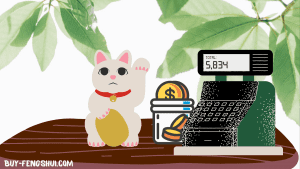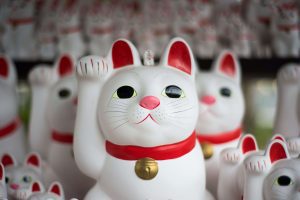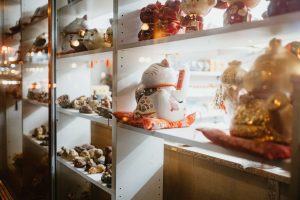What is a Chinese Lucky Cat ?

Despite the fact that feng shui originated in China, its modern application requires more than a working knowledge of traditional feng shui concepts and cures. Traditional and modern concepts are combined in a good feng shui home. The lucky cat is a traditional Japanese cure for good fortune, prosperity, and wealth.
Your goal should be to welcome and maintain a good flow of energy through your home or workplace to influence positivity in your life if you practice feng shui correctly. Integrate Feng Shui into home designs, furniture layout and features with any feng shui cures you might want or which needs careful consideration.
Symbols in Feng Shui for abundance
The use of Ganesh in Indian culture is comparable to feng shui’s use of the lucky cat. Both symbols are from non-Chinese cultures; the lucky cat is known as maneki neko in Japanese. Ganesh, the elephant-headed god, is the god of good fortune, wisdom, and success. Feng shui practitioners and enthusiasts will use a lucky cat or a trunk-upward elephant for luck and prosperity cures.
As with all feng shui cures, you should identify with the item that is adorning your home and sacred space. Use the lucky cat in your home because you enjoy its energy, not because it is feng shui-friendly.
If the lucky cat does not bring you good or strong feelings, try a bamboo plant or statues of elephants, fu dogs, dragons, or tortoises. Pay attention to your gut feelings and the energy or vibes that an item gives off. Is it a good fit for your individual style? When you look at it, does it make you feel happy or hopeful? You’ve come to the right place if that’s the case.

The Chinese lucky cat
Maneki neko translates to “gesturing cat” in Japanese. The lucky cat sculpture’s posture, which always depicts an upright paw, sometimes still, sometimes moving.
It is more common in public places than in private homes, such as retail stores, restaurants, and offices. Besides, it is the fortune cat or the money cat, which people use as a wealth and prosperity cure and a good luck cure.
It’s like a gentler version of fu dog, but with a different application. Yes, the cat is cuddly and inviting, but it also serves as a guardian. It has a raised paw that is gesturing but can also be a protective gesture, and it is made up of fresh white and red colours with black and gold accents.
You can see the lucky cat holding a round gold coin or a slightly rectangular ancient Japanese coin. There are also golden bells or other adornments, such as a red neck scarf. Gold and red are happy colours in Asian cultures, and when it combines with the freshness of white, the lucky cat exudes distinct energy that people are drawn to.
Where to place the lucky cat?
Commonly business uses it, but that does not mean you cannot use that at home. Place this money cure in your bagua’s wealth and money area (southeast) or in your home office as it’s a good money cure.
If you want to, you can carry the lucky cat’s energy around with you. You can see the lucky cat image on everything from t-shirts to key chains. Still, the best feng shui placement for a prosperous business is at the entrance to entice good customers and attract wealth.

